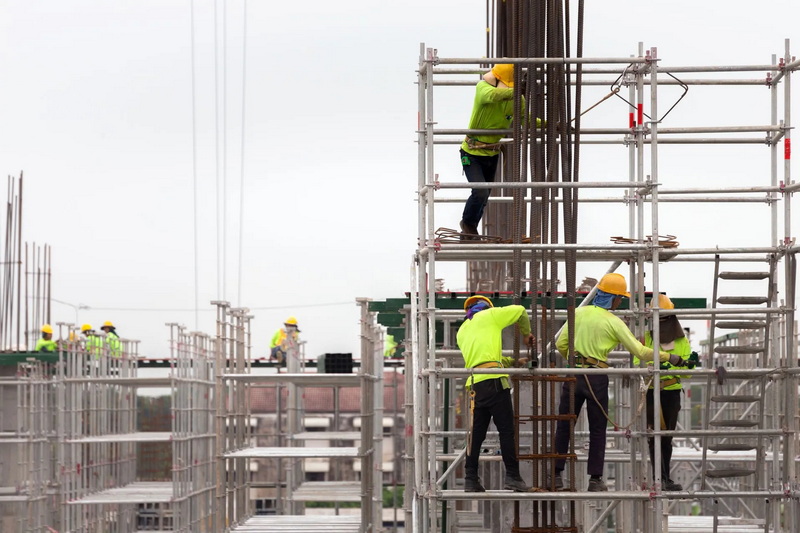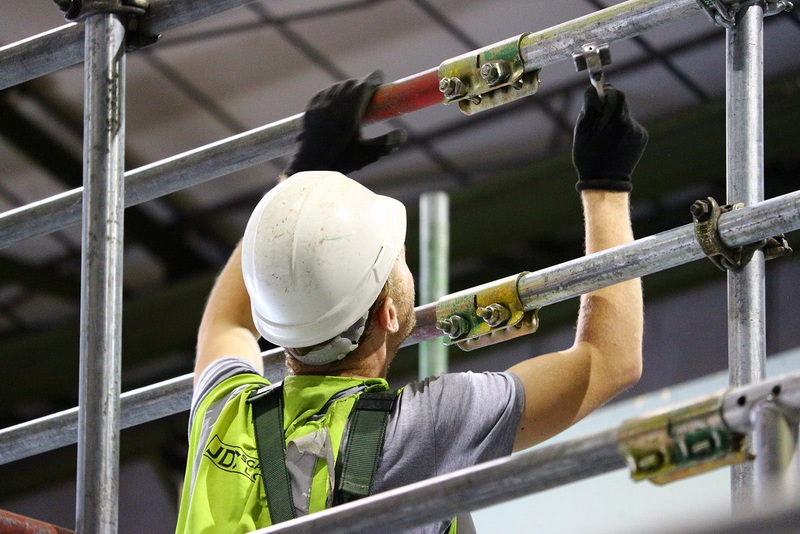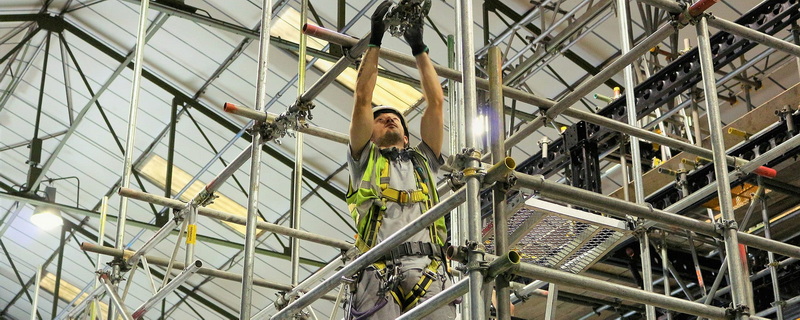Content Menu
● What Is Tube and Clamp Scaffolding?
● Is Tube and Clamp Scaffolding Easy to Erect for Beginners?
>> Advantages for Beginners
>> Challenges for Beginners
● Step-by-Step Guide to Erect Tube and Clamp Scaffolding
>> Step 1: Planning and Drawing the Scaffold Structure
>> Step 2: Prepare the Foundation
>> Step 3: Assemble the Base and Vertical Posts
>> Step 4: Install Horizontal Runners and Bearers
>> Step 5: Add Diagonal Bracing
>> Step 6: Erect Additional Levels
>> Step 7: Install Guardrails and Access
● Safety Tips for Beginners Erecting Tube and Clamp Scaffolding
● Common Mistakes Beginners Make and How to Avoid Them
● Advantages of Tube and Clamp Scaffolding for Beginners
● Disadvantages to Consider
● Additional Tips to Make Erecting Tube and Clamp Scaffolding Easier for Beginners
>> Use Proper Tools
>> Work in Teams
>> Take Training Courses
>> Follow Manufacturer Guidelines
>> Practice Makes Perfect
● Conclusion
● FAQ
>> 1. How long does it take for a beginner to erect tube and clamp scaffolding?
>> 2. What tools are needed to erect tube and clamp scaffolding?
>> 3. Can tube and clamp scaffolding be erected by one person?
>> 4. What safety precautions should beginners follow?
>> 5. Is tube and clamp scaffolding suitable for irregular building shapes?
Tube and clamp scaffolding is one of the most versatile and widely used scaffolding systems in construction and maintenance projects. Its adaptability to various site conditions, irregular shapes, and complex structures makes it a preferred choice for many contractors. But for beginners, the question often arises: Is tube and clamp scaffolding easy to erect? This detailed article explores the ease of erecting tube and clamp scaffolding, breaking down the process step-by-step, highlighting essential safety tips, common challenges, and practical advice.

What Is Tube and Clamp Scaffolding?
Tube and clamp scaffolding consists of three primary components:
- Galvanized steel tubes: Various lengths of steel tubes form the framework.
- Clamps (couplers): Connect tubes at right angles or swivel to allow flexible angles.
- Base plates: Distribute the load evenly on the ground.
This system allows for custom configurations, making it ideal for irregular building shapes or sites with obstructions.
Is Tube and Clamp Scaffolding Easy to Erect for Beginners?
Advantages for Beginners
- Simple Components: Only three basic components make it easier to understand.
- Flexibility: Can be adapted to many shapes and heights without special parts.
- Clear Assembly Logic: Tubes connect via clamps, which are tightened with a wrench, making the assembly straightforward.
- Stepwise Construction: Can be built in sections or zones, allowing manageable progress.
Challenges for Beginners
- Manual Labor Intensive: Requires physical strength to handle tubes and tighten clamps.
- Precision Needed: Proper measurements and alignment are essential to ensure stability.
- Safety Awareness: Understanding load capacities, bracing, and anchoring is critical.
- Time-Consuming: Compared to modular systems, erection can be slower for beginners.
- Learning Curve: Requires practice to efficiently handle clamps and tubes.
Overall, with proper training and supervision, beginners can successfully erect tube and clamp scaffolding safely.
Step-by-Step Guide to Erect Tube and Clamp Scaffolding
Step 1: Planning and Drawing the Scaffold Structure
Before starting, draw an accurate plan of the scaffold layout including:
- Dimensions and height.
- Number and placement of vertical posts (standards).
- Horizontal members (bearers and runners).
- Diagonal bracing.
- Platform locations.
- Access points (ladders or stairs).
- Anchor points for stability.
Step 2: Prepare the Foundation
- Ensure the ground is level, firm, and stable.
- Use mud sills or timber planks under base plates on soft or uneven ground.
- Position base plates on the prepared foundation to distribute load evenly.
Step 3: Assemble the Base and Vertical Posts
- Place the first vertical tube (standard) on the base plate.
- Secure the tube with a bayonet fitting on the base plate and twist to lock.
- Erect subsequent vertical posts at planned intervals (typically 6-8 feet apart).
- Use right-angle clamps to attach horizontal bearers near the base, about 12 inches above ground.
Step 4: Install Horizontal Runners and Bearers
- Attach horizontal tubes (runners) between vertical posts using right-angle clamps.
- Bearers support the platforms and are installed horizontally across runners.
- Use precise measurements to mark clamp positions on tubes for consistent spacing.
- Clamp bolts should be tightened to approximately 45 foot-pounds using a tube and clamp wrench.
Step 5: Add Diagonal Bracing
- Install diagonal tubes with swivel clamps to prevent sway and increase rigidity.
- Place bracing as close to the base as possible and at regular vertical intervals.
- Ensure diagonal braces are tight and properly aligned.
Step 6: Erect Additional Levels
- Repeat the process to build upward, erecting vertical posts, runners, bearers, and bracing.
- Ensure each level is plumb and square using a spirit level and measuring tape.
- Secure platforms with scaffold-grade planks on bearers.
Step 7: Install Guardrails and Access
- Install guardrails around platforms for fall protection.
- Attach ladders or stair systems securely to scaffold for safe access.
- Use toe boards to prevent tools or materials from falling.

Safety Tips for Beginners Erecting Tube and Clamp Scaffolding
- Always wear personal protective equipment (PPE) including hard hats, gloves, and safety boots.
- Never erect scaffolding alone; work in teams.
- Inspect all tubes and clamps before use for damage or defects.
- Follow manufacturer's torque specifications when tightening clamps.
- Ensure scaffold is plumb, level, and braced at all times.
- Use fall protection when working at heights.
- Do not overload platforms; adhere to load limits.
- Secure scaffolding to a stable structure if required.
- Attend scaffold erection training courses.
Common Mistakes Beginners Make and How to Avoid Them
| Mistake | How to Avoid |
| Loose or improperly tightened clamps | Use a torque wrench and follow specs (45 ft-lbs) |
| Skipping diagonal bracing | Install bracing early and regularly for stability |
| Uneven foundation | Prepare ground and use mud sills/base plates |
| Incorrect tube spacing | Measure carefully and mark before clamping |
| Overloading platforms | Know load limits and distribute loads evenly |
| Neglecting guardrails | Always install guardrails and toe boards |
Advantages of Tube and Clamp Scaffolding for Beginners
- Customizable: Can be adapted to complex structures and uneven terrain.
- Cost-Effective: Components are reusable and relatively inexpensive.
- Strong and Stable: Supports heavy loads when properly erected.
- Widely Used: Knowledge and training resources are abundant.
- Training Friendly: Clear steps and simple components make learning easier.
Disadvantages to Consider
- Time-Consuming: More labor-intensive than modular systems.
- Requires Skill: Proper technique essential for safety.
- Heavy Components: Physical strength needed to handle tubes and clamps.
- Regular Maintenance: Clamps and tubes need inspection and care.
Additional Tips to Make Erecting Tube and Clamp Scaffolding Easier for Beginners
Use Proper Tools
Having the right tools makes a significant difference. A quality tube and clamp wrench, torque wrench, spirit level, measuring tape, and safety harness are essential. Using a torque wrench ensures clamps are tightened to the correct specification, preventing both under-tightening and over-tightening.
Work in Teams
Erecting scaffolding is safer and more efficient when done in teams. Team members can help lift heavy tubes, hold components in place, and watch for safety hazards. Communication is key.
Take Training Courses
Many organizations offer scaffold erection training courses that cover theory and practical skills. Training improves confidence, reduces errors, and enhances safety awareness.
Follow Manufacturer Guidelines
Each manufacturer may have specific recommendations for their tube and clamp systems. Always refer to these guidelines for assembly, load capacities, and maintenance.
Practice Makes Perfect
Beginners should start with small scaffold setups to practice assembly techniques before moving on to larger, more complex structures.
Conclusion
Erecting tube and clamp scaffolding is achievable for beginners with the right guidance, training, and safety awareness. While it requires physical effort and attention to detail, the system's simplicity, flexibility, and adaptability make it an excellent choice for various construction projects. By following step-by-step instructions, using proper tools, and adhering to safety protocols, beginners can confidently erect tube and clamp scaffolding safely and efficiently. Practice, patience, and teamwork are key to mastering this versatile scaffolding system.

FAQ
1. How long does it take for a beginner to erect tube and clamp scaffolding?
Time varies by scaffold size and experience, but beginners can expect to take longer initially—possibly several hours for a simple scaffold. With practice, erection time decreases significantly.
2. What tools are needed to erect tube and clamp scaffolding?
Basic tools include a tube and clamp wrench (torque wrench), spirit level, measuring tape, hammer, and safety equipment (hard hat, gloves, boots).
3. Can tube and clamp scaffolding be erected by one person?
No, erecting scaffolding alone is unsafe. It requires teamwork for lifting, positioning, and securing components safely.
4. What safety precautions should beginners follow?
Always wear PPE, inspect components before use, ensure proper bracing, follow load limits, and never work on unstable or incomplete scaffolds.
5. Is tube and clamp scaffolding suitable for irregular building shapes?
Yes, its flexibility with swivel clamps allows it to adapt to irregular shapes and complex structures easily.






















